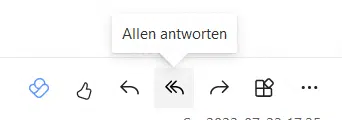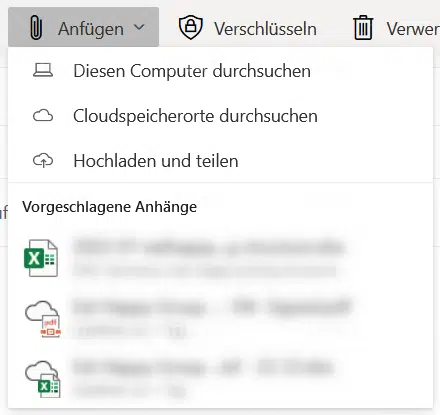Learning how to write an email in German is crucial as soon as you start working in Germany. Based on my own experience, I will teach you more about it.
Some years ago, I had the opportunity to study for one semester at a university in Germany. Since I had to clarify some details regarding the accommodation, I had to write my first email in German. Later, when I started working for a German company, I was supposed to start writing emails in German again.
Back then, I asked myself how to write an email in German. In his article, you’ll learn how to write business and private emails in German.
Key takeaways
- In this article, I will provide you with many essential key phrases that I use almost daily when writing emails in German.
- I will tell you more about the rules on how to write an email – and how I learned it on my own.
- You will also learn more about the essential elements of a German email client.
- After that, I will provide examples for formal greetings, how to write specific sentences in German for various occasions, and the proper email closure.
- Last but not least, I also included some links to tools where you can check your spelling and German grammar.
Topics in this article
Learning how to write an email >>
General rules on writing an email >>
The email address >>
The subject in an email in German >>
Greetings in an email in German >>
The opening sentence >>
Writing the email content >>
Email closure in German >>
Check spelling and grammar >>
How did I learn how to write an email in German?
My best help was provided by a book which I used extensively back then. It was called : “Briefe gut und richtig schreiben!”.
Meanwhile there is a newer version, “Briefe, E-Mails und Kurznachrichten gut und richtig schreiben”*. I highly recommend.
General rules on how to write an email
As I learned more about writing letters, I realized later in my job that writing an email in German is not that much of a difference. This guide will show you how emails in German are structured and more about the differences between private and business emails, including the dos and don’ts.
The structure of an email in German
An email, similar to a letter, starts with a greeting. When composing a formal email, you should mention the email’s purpose in the first sentences. Don’t forget to include the subject of your email in addition to that. I want to cover four different scenarios for you here.
Writing a business email in German
From what I learned, in case you don’t know each other, it’s helpful to briefly state who you are and why you are writing to the person. Describe the purpose, make a proposal and afterward, tell them what you would like them to do (reply or call, for example).
However, it may also be helpful to state when you need that kind of information or when you’d like to hear back from them.
Sending a follow-up email in German
In a situation where you’ve already met your acquaintance and are about to send a follow-up email, briefly remind the person who you are. Make sure to summarise what you already talked about, write down your answer, and let them know when you’d like them to get in touch with you.
Sending emails to apply for a job in German
With job applications, the requirements are slightly different.
First thing after the greeting, explain who you are and for which position you are applying. For more tips regarding job applications, you can refer to my article about how to apply for a job in Germany.
You may close your email by mentioning what documents you attached (usually your CV but sometimes your additional certificates or recommendation letters). Then you should close your email with a formal closing.
Writing an informal email in German
Informal emails are slightly different and not necessarily as structured as formal ones. You may also include general questions about how they are doing, how their family is doing, or similar. After their greeting, Germans tend to get to the point very quickly.
The last request you should include is when you’d like them to get back to you with an answer. Then you can close your email with an informal closing.
Differences between private and business emails in German
So, where are German’s main differences between personal and business emails? The main difference, of course, is the greeting and the closing formula you should use. While business emails are more straight to the point, private emails tend to be more personal, talking about private matters.
Just think about it as if you are talking to a friend or a business partner.
Dos and don’ts when writing emails in German
- For business emails, always use formal greeting and closing formulas.
- Keep emails as short as possible without leaving essential things out.
- Don’t forget to ask for a reply and include your expectations about a timeframe, especially when an email is business related.
- When sending files, you should briefly mention what those are about or why you are sending those.
- You should make sure that you are checking your grammar and your writing. The shorter the sentences are, the easier your recipient can catch what this email is about.
The email address
As you might already be aware of different ways of including someones email address to an email, in a German email client, things look a bit different. The naming differs from any English email client in some cases. I took all those examples out of my German Microsoft Outlook version.
Important address fields

In the field that’s named “An” (meaning “TO”), you should include the primary recipients of your email.

If you want to copy in someone to inform them about your communication, the correct form field to use is the “Cc” field. CC stands for carbon copy.

In case you need to blind copy someone in so that the primary recipient (“An” field) and those that are copied in (“Cc” field) can’t see who else is included, you can use the “Bcc” form field. Bcc means blind carbon copy.

The field where it says “Betreff hinzufügen” is there to add a subject line to the email you are about to send.
How to reply or forward an email in German

To reply to an email and the sender only, use the “Antworten” icon you can see above.

If you want to send your reply to all of the included recipients, make sure to use the “Allen antworten” or answer all icon.

Forwarding emails to someone else is straightforward. Use the “Weiterleiten” icon you can see above. A new window with the same email will open and let you put in new recipients.
Sending and discarding a German email

When you are ready to send an email, please use the ” Senden ” button.

If you’d like to discard an email, the button you should use for it is called “Verwerfen,” which means “dump” in English.
Attaching files to an email in German

It would be best if you used the “Anfügen” button to attach a file to an email. This button offers different functionality in most cases, as you can see in the screenshot above.
- “Diesen Computer durchsuchen” lets you search your local PC for files you’d like to attach to an email. Those files will be attached directly to the email.
- If you use the Microsoft Cloud (or Microsoft One Drive) to save your files online, you can start your search using “Cloudspeicherorte durchsuchen”.
- “Hochladen und teilen” works in a similar way as “Diesen Computer durchsuchen“. It lets you search for files on your local computer. A second step will upload the files to Microsoft One Drive and afterward only attach a copy of the file in the cloud.
“Vorgeschlagene Anhänge” means suggested attachments. Most of the time, recently edited files are in this list and can be attached automatically. This can save some time searching and finding files significantly.
The subject in an email in German / Betreff
Here are a few phrases that I often use in an email in German. As mentioned above, if you use a German email client, use the field “Betreff” for it.
Here are a few basic rules:
- Always write the first word with a capital letter at the beginning
- Germans do not use a “.” at the end of a subject in an email in German
- Keep a subject short and sweet
- Be as specific as possible
Here are some examples:
- Rückfrage zu Ihrem Auftrag vom 20.07.2022 – „Question regarding your order from 20th of July 2022“
- Terminanfrage vierteljährliches Meeting – „Appointment request quarterly meeting”
- Ihre Bestellung vom 20.07.2022 – “Your order from 20th of July 2022”
When I work with internal teams on different client projects, I tend to put in the client name first, followed by “|” and the email’s subject. Here is an example:
(client name) | Status Quo – Projekt technisches Setup – (client name) | status quo – technical setup project
Formal and informal greetings and salutations in an email in the German language
Here are some common formal and informal salutations and greetings in a German email based on my experience.
Formal greetings and salutations in an email in the German language
- Sehr geehrte (include her last name) for “Dear Ms. (last name) ”
- Sehr geehrter (include his last name) for “Dear Mr. (last name)”
- Sehr geehrter Herr Doktor (his last name) for „Dear doctor (last name)“
- Sehr geehrte Frau Doktor (her last name) for „Dear doctor (last name)“
- Sehr geehrte Damen und Herren for “Dear Sir or Madam”
- Guten Tag, Herr (include his last name) for “Good day Mr. (last name)”
- Sehr geehrte Kollegen for “Dear colleagues” is only applicable if you say “Sie” to some or most of them
Informal greetings and salutation in a German email
- Liebe Frau (her last name) for “Dear Ms. (last name)”
- Lieber Herr (his last name) for “Dear Mr. (last name)”
- Lieber (his first name) for “Dear (first name)”
- Liebe (her first name) for “Dear (first name).”
- Hallo (her first name) and (his first name) for “Dear (her first name) and (his first name)”
- Hallo for “Hello”
How to write the opening sentence in an email in German
I want to provide examples for opening sentences in an email in German that you may use after the formal or informal greeting in a German email.
- Ich wollte mich bei Ihnen über den aktuellen Projektverlauf erkundigen. – “I wanted to check in with you about the current progress of the project.”
- Ich hoffe, es geht Ihnen gut. Hier einige updates von meiner Seite zu dem aktuellen Projekt. – „I hope things are going well for you. Here are some updates from my side about the current project.”
- Vielen Dank für Ihre Anfrage. Anbei erhalten Sie einige erste Informationen im Anhang als PDF-Datei. – „Thank you very much for your inquiry. Please find attached some initial information as a PDF file.”
The email content or how to write the main part of the email
Here you can find some examples and useful phrases for email content or how to write the central part of the email in German.
Requests
Requests are often included at the end of an email. If you want to keep your email formal, you should use the word “bitte” (please).
Könnten Sie uns bitte die entsprechenden Unterlagen per E-Mail bis zum 20.07.2022 zusenden? – „Could you please send us the relevant documents by email by 20/07/2022?“
Bitte lassen Sie uns wissen, wenn Sie weitere Informationen zu dem Auftrag benötigen, um eine fundierte Entscheidung treffen zu können. – „Please let us know if you need more information on the job to make an informed decision.“
Propositions
Here is a good example when asking someone for the approval of something in a very polite way.
Ich möchte Sie bitten, den Auftrag bis zum 20.07.2022 zu unterzeichnen, damit wir rechtzeitig mit dem Projekt starten können und alle Timings entsprechend halten können. – „I would like to ask you to sign the order by 07/20/2022 so that we can start the project on time and keep all timings accordingly.“
Invitations
Gerne möchte ich Sie zu unserer Firmenveranstaltung am, 20.07.2022 einladen. Sie können gerne Ihre Partnerin oder Ihren Partner mitbringen. – „I would like to invite you to our company event on, 20.07.2022. You are welcome to bring your partner.“
Wir würden uns freuen, wenn Sie bei der Besprechung am 20.07.2022 selbst dabei sein können, da wir gerne die Jahresstrategie präsentieren würden. – „We would be happy if you can be present at the meeting on 20/07/2022 itself, as we would like to present the annual strategy.“
Thank you letters
Vielen Dank für die Einladung zu dem Job-Interview. Ich habe mich sehr darüber gefreut. – „Thank you very much for the invitation to the job interview. I was very happy to receive it.“
Besten Dank für Ihr Vertrauen in unsere Dienstleistung. Wir freuen uns auf eine gute Zusammenarbeit in den nächsten Monaten. – „Thank you very much for your trust in our service. We look forward to a good cooperation in the coming months.“
Vielen Dank für die Zusendung der Unterlagen. Ich werde diese in den kommenden Tagen überprüfen. – „Thank you very much for sending me the documents. I will review them in the coming days.“
Email closure in German
Closing an email properly in German is nearly as important as the initial formal or informal greeting. Here are some examples that you can use daily.
- Mit freundlichen Grüßen – “With kind regards“
- Mit besten Grüßen – “Best regards”
- Beste Grüße – “Best regards”
- Viele Grüße (short VG) – “Many greetings”
- Liebe Grüße (short LG) – “Kind regard”
- Bis bald – “See you soon”
The more formal an email is, the less likely you will use your first name after the email closure in German. One example:
“Beste Grüße, (first name)” is less formal than “Beste Grüße, (first name and last name)” or even “Beste Grüße, (last name)”.
Check the spelling and grammar
As mentioned at the beginning of this article, you should always check your correspondence in German for spelling and grammar. There are a few helpful tools that you may use.
Microsoft Outlook and Microsoft Word allow you to use internal spell-checking. Most of the time, this works well, but sometimes it does not recognize sentence structure well enough. But the suggestions are also quite limited.
An excellent online tool you might consider using would be DeepL Translator. You can enter your text in English or any other of the 27 languages (besides German) it offers and look up the translation in German.
To look up specific words or phrases, you may also consider using the online grammar test Duden.
Conclusion
Learning how to write an email in German might sound scary at first. From my own experience, I can tell you that by doing it every single day, you will soon get better at it. I hope you can reuse some of the phrases I’ve mentioned here.
USEFUL INFORMATION ABOUT LEARNING GERMAN
> 25 Formal Greetings in German You Should Know
> Top 10 German Language Level Test Tools Online Today
> German Language Levels Explained
> Is it hard to learn German? No, if you follow these simple tips
> What level of German is required to work in Germany today?
> 6 tips on How to Learn German A1 at home gets Super EASY
> 10 Ways To Learn Business German Fast
> Checked: How to get B2 Level in German at Goethe Institut
> Effective Online Courses For German Language
* The links that are marked in this way are affiliate links and indicate that we receive a small commission if you decide to buy the products or services offered by our partner sites. But for you, it won’t cost anything extra.

